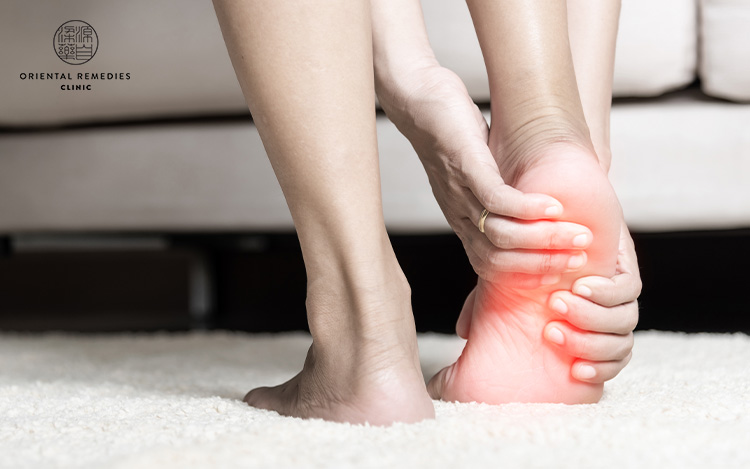Key Takeaways
- Plantar fasciitis is typically caused by inflammation of the plantar fascia. This condition often worsens due to overuse, tight calf muscles, and poor foot mechanics.
- In Traditional Chinese Medicine (TCM), plantar fasciitis is believed to be caused by Qi and Blood stagnation, Organ deficiencies, and external factors.
- Therapies like acupuncture, cupping, herbal medicine, Electro-Lymphatic Therapy (ELT), and Cell-Pro Therapy (CPT) address both the symptoms and root causes of heel pain.
Understanding Plantar Fasciitis and Care Options
Plantar fasciitis can make even the simplest movements—like getting out of bed or walking to the bus stop—feel painful. For many in Singapore, this common heel condition disrupts daily life. Some individuals explore TCM as a natural option that focuses on the body’s internal balance, alongside symptom management. This article explores how TCM approaches plantar fasciitis and the therapies that may support recovery and your overall foot health.
What Is Plantar Fasciitis?
Plantar fasciitis refers to the inflammation of the plantar fascia, which is a ligament that runs across the bottom of your foot and connects your heel bone to your toes. This condition often leads to a sharp, stabbing sensation in the heel. This is usually observed during the first steps after waking up or following extended periods of inactivity[1].
Causes of Plantar Fasciitis
In Western medicine, common causes of plantar fasciitis[2] include:
- Overuse or repetitive stress from prolonged walking, running, or standing
- Irregular foot structures, such as flat feet
- Tightening of the calf muscles or the Achilles tendon
- Inadequate footwear or sudden increases in activity levels
Plantar Fasciitis from a TCM Perspective
In TCM, plantar fasciitis is viewed through a broader lens. Pain and inflammation are the result of internal imbalances, including:
-
Qi and Blood Stagnation
One of the foundational texts of TCM, the Huang Di Nei Jing (黄帝内经, Inner Canon of the Yellow Emperor), states: “Excessive standing strains the bones; excessive walking strains the tendons.” Prolonged standing and physical strain can cause damage to the musculoskeletal structure of the legs and feet, disrupting the circulation of Qi (vital energy) and Blood in the lower limbs. This causes Qi and Blood stagnation, resulting in pain, swelling, and impaired healing in the affected area.
-
Dampness Accumulation
A sedentary lifestyle causes poor circulation, leading to a buildup of Dampness. Dampness tends to accumulate in the lower limbs, often resulting in sensations of heaviness, swelling, and stiffness in the plantar fascia.
-
Liver and Kidney Deficiency
In TCM, the Liver directly affects the tendons, while the Kidney supports bone health. Weakness in these Organs can make tendons more prone to injury and slow down the healing process, especially in chronic cases of plantar fasciitis.
How Do TCM Physicians Treat Plantar Fasciitis?
While Western treatments tend to focus on symptom management through medication, insoles, or physical therapy, TCM in Singapore offers a holistic approach. It focuses on addressing both the pain and the root imbalances contributing to the issue.
Here are some common therapies that your physician may recommend as part of a personalised care plan:
-
Acupuncture
In Chinese acupuncture, specific acupoints along the meridians are stimulated to regulate the flow of Qi and Blood. This TCM treatment relieves inflammation as well as helps reduce tension in the foot and surrounding muscles, offering a natural approach to foot pain relief. Sessions are customised based on the individual’s condition and body constitution, with treatment durations commonly spanning 4 to 8 weeks. The speed of recovery also depends on supporting factors such as proper lower limb care (such as wearing suitable footwear) and incorporating rehabilitative exercise as part of the overall treatment plan.
-
Cupping Therapy

Cupping therapy promotes circulation through a suction effect that draws stagnant Qi and Blood to the surface. This helps alleviate tension by releasing tight calf muscles and easing soft tissue strain on the plantar fascia. This helps to relax the muscles, relieve discomfort, and improve mobility in the affected area.
-
Herbal Medicine
A registered TCM physician will prescribe a customised herbal formula based on your individual body constitution and symptoms. These herbs work together to strengthen the tendons, improve the flow of Qi and Blood, dissipate Dampness, and provide pain relief.
-
Electro-Lymphatic Therapy (ELT)

ELT, a tech-enhanced therapy offered by Oriental Remedies Clinic, may be employed for patients with plantar fasciitis. This gentle, non-invasive procedure is designed to stimulate the lymphatic system, which in turn helps boost the body’s natural process of fluid regulation and waste removal. This enhances the removal of metabolic waste buildup in the foot, which can ease pain and reduce swelling.
-
Cell Pro Therapy (CPT)
In CPT, negatively charged ions are delivered through the skin in targeted areas, enhancing tissue repair and cellular recovery. It is commonly used to help reduce inflammation[3], ease discomfort, and support the body in managing issues related to pain. CPT is also often integrated into broader wellness plans, helping patients feel more relaxed and at ease.
Taking a Holistic Approach to Healing Heel Pain
When it comes to managing plantar fasciitis, addressing only the symptoms may provide short-term relief but might not address the underlying factors. TCM treatments for plantar fasciitis take a broader view, aiming to support your overall well-being by considering circulation, Qi and Blood stagnation, individual body constitution, and more.
At Oriental Remedies Clinic, each treatment plan is personalised based on your unique condition. Whether you’re managing a recent injury or ongoing heel discomfort, our approach combines TCM principles with modern technologies to support your wellness goals.
Get in touch to learn more about how we can help.
—
This article is written by Physician Sun Shuo and Physician Tan Boon Han, registered TCM physicians certified by the Traditional Chinese Medicine Practitioners Board (TCMPB).


Note: all words in Italics mentioned henceforth refer to the TCM organ system and not the anatomical organs/terms referenced in Western medicine.
Disclaimer:
The content on this page is for information and educational purposes only. Such medical information may relate to disease, injury, drugs and other treatments, medical devices and/or health products. Medical information does not amount to advice, and if advice is needed an appropriate professional help should be sought. The disclaimer asserts that no warranties or representations are given in respect of the medical information, and that the website operator should not be held liable if a user suffers any injury or loss after relying upon the medical information.
Any devices used for technology-enhanced therapies are intended for use only for general well-being purposes or to encourage or maintain a healthy lifestyle, and is not intended to be used for any medical purpose (such as the detection. diagnosis, monitoring, management or treatment of any medical condition or disease). Any health-related information provided by this device or software should not be treated as medical advice.
References:
[1] https://www.mayoclinic.org/diseases-conditions/plantar-fasciitis/symptoms-causes/syc-20354846
[2] Restivo J. Plantar fasciitis: Symptoms, causes, and treatments. Harvard Health. https://www.health.harvard.edu/pain/plantar-fasciitis-symptoms-causes-and-treatments. Published November 3, 2023.
[3] Oschman JL. Can electrons act as antioxidants? A review and commentary. J Altern Complement Med. 2007 Nov;13(9):955-67. doi: 10.1089/acm.2007.7048. PMID: 18047442.

